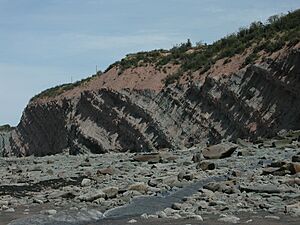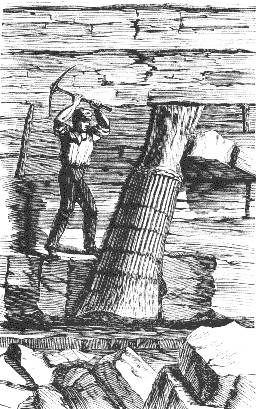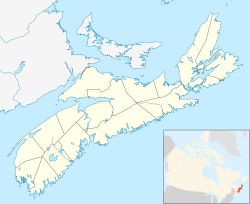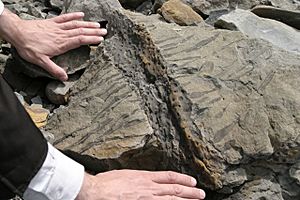Joggins facts for kids
Quick facts for kids
Joggins
|
|
|---|---|
|
Community
|
|

View of the Joggins Fossil Cliffs
|
|
| Country | |
| Province | |
| Municipality | Cumberland County |
| Incorporated | 1889 |
| Dissolved | 1949 |
| Time zone | UTC-4 (AST) |
| Official name: Joggins Fossil Cliffs | |
| Type: | Natural |
| Criteria: | viii |
| Designated: | 2008 (32nd session) |
| Reference #: | 1285 |
| Region: | Europe and North America |
Joggins is a small community located in western Nova Scotia, Canada. It is famous for its amazing fossil cliffs, which are like a giant history book made of rock! These cliffs stretch for about 15 kilometers along the coast.
The Joggins Fossil Cliffs are so special that UNESCO made them a World Heritage Site in 2008. This means they are important for everyone in the world to protect and learn from.
Contents
History of Joggins
| Historical populations | ||
|---|---|---|
| Year | Pop. | ±% |
| 1901 | 1,088 | — |
| 1911 | 1,648 | +51.5% |
| 1921 | 1,732 | +5.1% |
| 1931 | 1,000 | −42.3% |
The Mi'kmaq people, who are the Indigenous people of this area, called it "Chegoggins." This name means "place of the large fish weir," which was a trap used to catch fish. Later, French and English settlers changed the name to Joggins.
Joggins is located on the Cumberland Basin, which is part of the Bay of Fundy. For a long time, people here mined coal. The coal seams, or layers of coal, are visible right along the shore. People started digging for coal as early as 1686.
The first commercial mine was started in 1731 by Major Henry Cope. However, the Mi'kmaq people destroyed it in 1732. Later, in 1819, Samuel McCully opened another mine. He shipped coal by sea to places like Saint John, New Brunswick. But his business closed in 1821 after mining less than 600 tons.
Big mining companies came to Cumberland County in the mid-1800s. The General Mining Association began mining in Joggins in 1847. Coal production grew even more after the Intercolonial Railway was built in the 1870s. In 1887, the Joggins Railway opened, connecting the mines to the main railway line.
Old coal mine tunnels can still be seen eroding out of the sea cliffs today. Scientists have studied the wooden supports from these tunnels. They found that most of the wood dates back to the 1860s and 1870s.
The coal mines brought many different workers to Joggins. Some were as young as 12 years old. French-speaking Acadians returned from New Brunswick, and people from Ireland and Scotland also came to work.
Joggins Mines grew quickly. It had three churches, two cemeteries, a hotel, a roller skating rink, a movie theater, a fire department, a general store, a post office, a railway station, and a school. Coal mining became so important that Joggins became an official town in 1919.
However, the local coal mines started to decline. Many people moved away, and the town lost its official status in 1949. The coal mined in Joggins mostly went to power plants near Maccan. But these plants became old-fashioned by the 1950s. The mines closed shortly after the Springhill Mining Disaster in 1958. Train service to Joggins stopped in the early 1960s.
In the 1800s and early 1900s, Joggins was also known for other things. People quarried limestone for grinding wheels, cut lumber, fished, and produced dairy products. The Bay of Fundy also had a strong tradition of shipbuilding. Wooden ships were built on the shore to carry coal and mill stones to the United States. Many old homes in Joggins show the beautiful woodworking skills of these shipbuilders.
Today, Joggins is known for tourism and growing wild blueberries. The roads and bridges to Joggins were improved in the 1980s and 1990s. The area is now popular for tourists, summer homes, and retirees.
Joggins is part of the Glooscap Trail, a scenic drive along the Bay of Fundy. Mi'kmaq legends tell of a mythical transformer named Glooscap. He created Nova Scotia and controlled the great tides with his magic. The Bay of Fundy has the highest tides in the world. Visitors can walk on the ocean floor at low tide or go rafting on the tidal bore. The high tides have shaped the landscape into a beautiful place with beaches, rock formations, sea cliffs, waterfalls, and forests.
The Joggins area has many different plants and animals. Eagles, osprey, and moose are often seen. In the fall, many birdwatchers visit. The rich marshes, first built by the Acadians in the 1600s, attract hundreds of thousands of migrating birds.
Joggins has been famous for its fossils since the early 1800s. These fossils are found in the exposed coal layers in the cliffs. The daily high tide wears away the cliff, and the stone fossils fall onto the shore when the tide goes out. Fossils have also been found deep inside old mines and in drilled core samples. Joggins is one of the easiest places in the world to find early "Coal Age" fossils.
The Joggins Fossil Centre is a museum built right on the fossil cliffs. It displays fossils and teaches visitors about the cliffs' geology. You can also learn about the history of scientific discoveries in Joggins and how coal mining affected the community. The center offers guided tours of the cliffs and is open during certain seasons.
Joggins Fossil Cliffs: A Window to the Past

Joggins is famous for its amazing collection of fossils. These fossils show what a rainforest ecosystem looked like about 310 million years ago. This time is known as the "Coal Age" during the Late Carboniferous Period.
The stunning coastal cliffs, known as the Joggins Fossil Cliffs, are constantly being shaped by the tides in the Cumberland Basin. This means new fossils are always being uncovered! Geologists first became interested in this area in the late 1820s. Scientists like Abraham Gesner and Richard Brown made important observations.
The true fame of Joggins began in the mid-1800s when Charles Lyell visited. He was a very important geologist who wrote Principles of Geology. In his book Elements of Geology (1871), Lyell called the Joggins cliffs "the finest example in the world" of Coal Age rocks and fossils.
The fossils at Joggins are even mentioned in Charles Darwin's famous book, On the Origin of Species. They also played a part in a big debate about evolution in Oxford in 1860.
Much of the early work to study the fossils at Joggins was done by Sir William Dawson. He was a geologist from Nova Scotia who worked closely with Charles Lyell. Many of Dawson's fossil collections are now at the Redpath Museum at McGill University. Other important geologists who worked here include Abraham Gesner, who invented kerosene, and William Edmond Logan, who carefully measured every layer of the cliffs for the Geological Survey of Canada.
In 1852, Lyell and Dawson made an exciting discovery. They found tetrapod fossils (early four-legged animals) inside an upright fossil tree at Coal Mine Point. Later, Dawson found one of the most important fossils ever: Hylonomus lyelli. This is the earliest known sauropsid (reptile) in the history of life! In 2002, Hylonomus lyelli was named the official provincial fossil of Nova Scotia. Another important early tetrapod fossil found here is Protoclepsydrops, which is even older than Hylonomus.
Other amazing fossils found at Joggins include different types of plants like calamites (horsetails), lepidodendron, and sigillaria. Scientists have also found various early amphibian species, many kinds of fish (including evidence of coelacanths), and different arthropod species (like insects and spiders).
Besides individual fossils, the Joggins Fossil Cliffs are important because they show us what Earth was like when a tropical rainforest covered Nova Scotia. More recent fossil discoveries suggest that these rainforests disappeared quickly. This event is called the Carboniferous Rainforest Collapse, and it caused a mass extinction.
You can also find trackways made by a giant arthropod called Arthropleura at Joggins. The tree-like plant Sigillaria is famously preserved standing upright, just as it grew, at Joggins.
Recent Discoveries and Research
There has been a lot of new interest in Joggins over the last 20 years. Recent geological work has been led by Martin Gibling, a professor at Dalhousie University.
Amateur fossil collectors have also helped scientists learn a lot. For example, Don Reid, who lived in Joggins for a long time, gave his entire collection of Joggins fossils to the Joggins Fossil Institute. Many of his fossils are now on display at the Joggins Fossil Centre.
In 2009, Melissa Grey became the first scientific curator for the Joggins Fossil Institute (JFI). The Joggins Fossil Institute continues to support and do research at the site. They host paleontologists and geologists from all over the world. The JFI also has a Science Advisory Committee. This group of volunteer scientists helps guide the institute on how to develop, protect, and manage the Joggins Fossil Cliffs. They also advise on the museum's programs and scientific research.
World Heritage Site Status
In 2007, Canada nominated a 14.7-kilometer section of the Joggins coast to UNESCO as a natural World Heritage Site. It was officially added to the World Heritage List on July 7, 2008.
IUGS Geological Heritage Site
The International Union of Geological Sciences (IUGS) recognized the Joggins Fossil Cliffs as one of the top 100 'geological heritage sites' in the world. This happened in October 2022. They called it the 'world's best example of 'Coal Age' tropical forests and the site of its oldest known reptiles.'
An IUGS Geological Heritage Site is a very important place with geological features or processes. It is used as a reference for science and has helped geology grow throughout history.
Gallery
-
Sigillaria lycopod fossil, showing its bark impression (Canadian one dollar coin, 26.5mm for scale)
-
Calamites (horsetail) fossil
-
Beach, showing Carboniferous stratification
See also
 In Spanish: Joggins para niños
In Spanish: Joggins para niños







